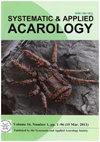芒果作物螨的多样性及株内分布
IF 1.2
3区 农林科学
Q2 ENTOMOLOGY
引用次数: 0
摘要
摘要农业环境中节肢动物群落的有效管理需要了解寄主作物物种的多样性和分布。因此,我们进行了这项研究,以评估芒果植物中最丰富的螨类的丰富度、丰度和植物内分布。每月收集叶片或生殖结构,考虑不同的冠层象限(北、南、东和西)、枝条的位置(基部、中间和顶端),以及在叶片的情况下,它们在枝条上的位置(基底、中间和顶部)。共鉴定出螨科12科28种。肯尼亚Cisaberoptus kenyae、Vilaia palithus和芒果寡叶螨是最丰富的植食性物种,分别占采集螨总数的87%、6%和3%。帕米斯维拉亚是南半球最丰富的物种。幼虫Amblysius largoensis(Phytoseidae)和Cunaxa sp1。(Cunaxidae)是捕食者中数量最多的(分别为15.1%和13.1%)。在芒果基部和中部枝条的基部和中间叶中观察到最高水平的多样性。这些物种的植物内分布受植物结构和地理位置的影响。大多数物种在芒果叶上发现,而其他物种则在花序和/或果实上定植,但密度较低。在这项研究中,我们在芒果植物中发现了相当多的植食性和捕食性螨。这些捕食性螨虫可能对控制芒果害虫至关重要。本文章由计算机程序翻译,如有差异,请以英文原文为准。
Mite diversity and intra-plant distribution in mango crop
Abstract Effective management of arthropod communities in agricultural environments requires knowledge of the diversity and distribution of species that inhabit host crops. Therefore, we conducted this study to evaluate the richness, abundance, and intra-plant distribution of the most abundant mite species in mango plants. Leaves or reproductive structures were collected monthly considering the different canopy quadrants (North, South, East, and West), the position of the branch (basal, median, and apical), and, in the case of leaves, their position on the branch (basal, median, and apical). A total of 28 species belonging to 12 mite families were identified. Cisaberoptus kenyae, Vilaia pamithus, and Oligonychus mangiferus were the most abundant phytophagous species, accounting for 87%, 6%, and 3% of the total number of mites collected, respectively. Vilaia pamithus was the most abundant species in the southern quadrant. Amblyseius largoensis (Phytoseiidae) and Cunaxa sp1. (Cunaxidae) were the most abundant among the predators (15.1% and 13.1%, respectively). The highest level of diversity was observed in the basal and median leaves of the basal and median branches of mangoes. The intra-plant distribution of these species was influenced by plant architecture and geographical position. Most species were found on mango leaves, whereas other species colonized inflorescences and/or fruits, but at low densities. In this study, we found considerable diversity of phytophagous and predator mites in mango plants. These predator mites may be crucial for controlling mango pests.
求助全文
通过发布文献求助,成功后即可免费获取论文全文。
去求助
来源期刊

Systematic and Applied Acarology
ENTOMOLOGY-
CiteScore
2.20
自引率
33.30%
发文量
152
期刊介绍:
Systematic and Applied Acarology (SAA) is an international journal of the Systematic and Applied Acarology Society (SAAS). The journal is intended as a publication outlet for all acarologists in the world.
There is no page charge for publishing in SAA. If the authors have funds to publish, they can pay US$20 per page to enable their papers published for open access.
SAA publishes papers reporting results of original research on any aspects of mites and ticks. Due to the recent increase in submissions, SAA editors will be more selective in manuscript evaluation: (1) encouraging more high quality non-taxonomic papers to address the balance between taxonomic and non-taxonomic papers, and (2) discouraging single species description (see new special issues for single new species description) while giving priority to high quality systematic papers on comparative treatments and revisions of multiple taxa. In addition to review papers and research articles (over 4 printed pages), we welcome short correspondence (up to 4 printed pages) for condensed version of short papers, comments on other papers, data papers (with one table or figure) and short reviews or opinion pieces. The correspondence format will save space by omitting the abstract, key words, and major headings such as Introduction.
 求助内容:
求助内容: 应助结果提醒方式:
应助结果提醒方式:


